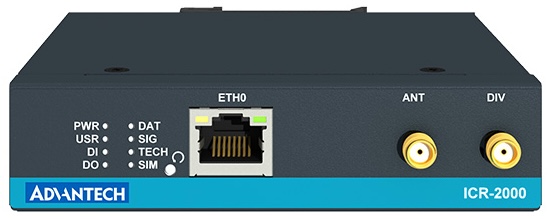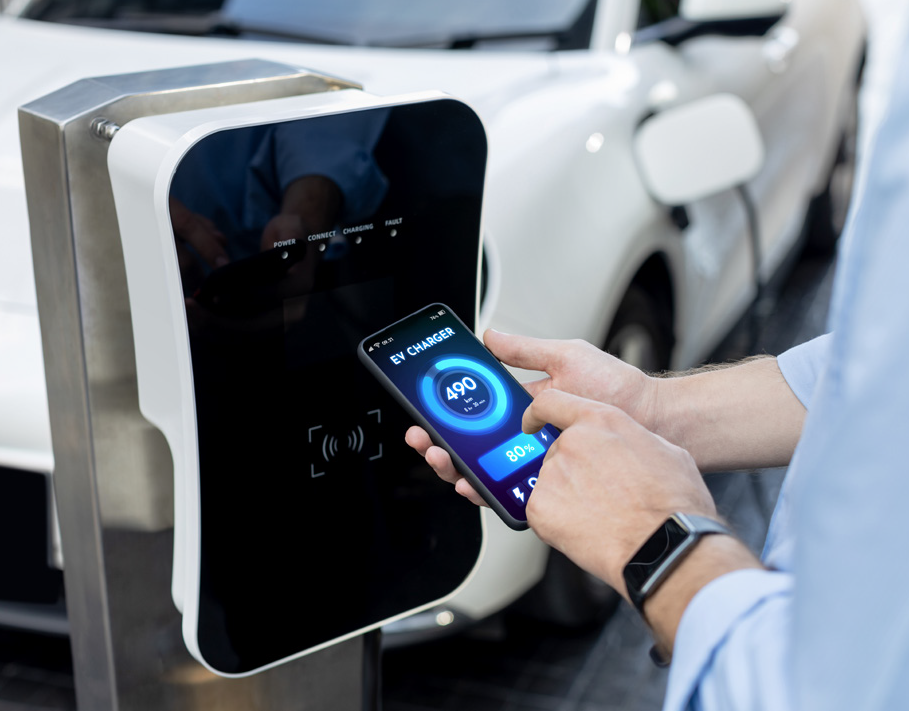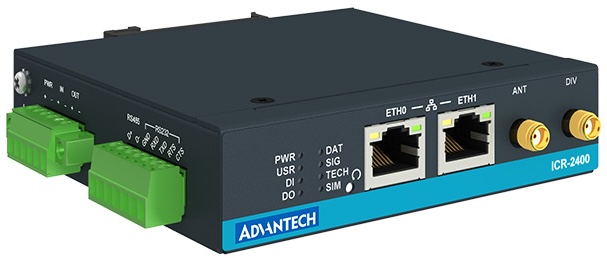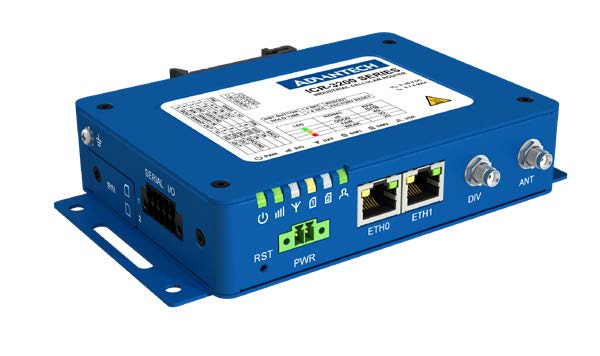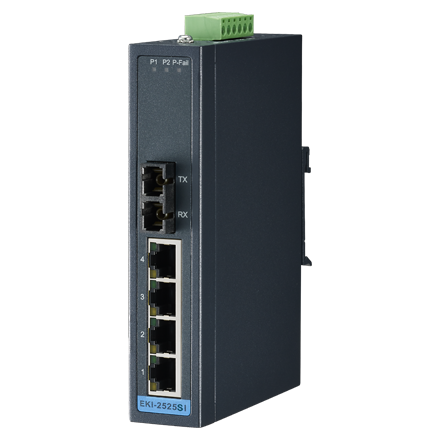
How Cellular Technologies Solve Common Connectivity Challenges for Electric Vehicle Charging
With the electric vehicle market expanding, the reliability and adaptability of cellular connectivity is essential to support seamless operation and growth of charging infrastructure. Find out how as we explore this growing technology sector.
The electric vehicle (EV) industry is accelerating at a rapid pace, leading to an increased need for robust EV charging infrastructure. As of February 2023, U.S. cumulative plug-in electric vehicle (PEV) sales surpassed 3.4 million, with PEV sales making up 7% to 10% of all light-duty vehicles (LDVs). The growth in PEV sales has been accompanied by a similar growth in PEV capabilities, with driving range and charging power improving dramatically in recent years. However, the deployment and operation of electric charging points are not without challenges— particularly when it comes to reliable and secure connectivity.
With federal and state policies increasingly showing support for EV consumers and manufacturers, the urgency for establishing charging infrastructure is more critical than ever. The International Energy Agency (IEA) predicts global EV sales will hit 22 million by 2030, with 2.3 million sales expected in the U.S. alone.2 The IEA also forecasts the number of EV charging stations will increase to 13 million globally by
2030, including an estimated 800,000 across the U.S. To power the growing wave of electric-based fleets and consumer vehicles, efficient and reliable battery charging stations are crucial. Worldwide governments are expected to continue support for public charging infrastructure, especially in the U.S. A goal set by the U.S. National Electric Vehicle Infrastructure (NEVI) plan, established by the federal Bipartisan Infrastructure Law and signed in 2021, includes building a nationwide network of 500,000 chargers by 2030.
Many of these new stations will be installed, operated, and/or maintained by private entities under a variety of business models. Complementing this goal, the U.S. Federal Highway Administration also introduced new national standards for EV chargers funded by the federal government. These standards aim to guarantee consistency, reliability, accessibility, and compatibility across charging infrastructure.
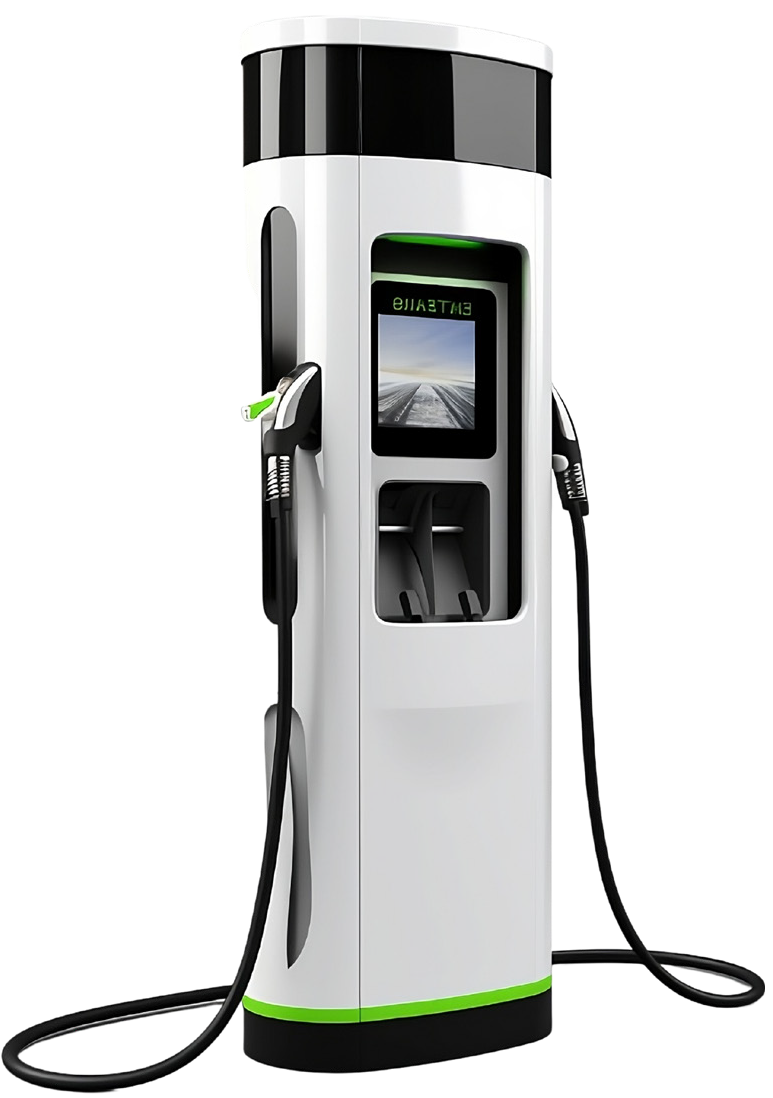
Main Types of EV Charging
EV charging technology is evolving swiftly alongside expanding network infrastructure. While the definitions of charging levels may vary slightly across regions, markets, and policies, here we refer to charging ratings as:
- Level 1 (slow charging using AC)
- Level 2 (slow to fast charging using AC)
- Direct Current Fast Charging (DCFC)or Level 3
Slower, or Level 1 (L1), chargers are overwhelmingly located in private residences, commonly used overnight. Public charging stations consist of Level 2 (L2) and DCFC ports, with L2 chargers often found in areas where vehicles are parked for extended periods, including retail centers, airports, hotels, government buildings, and businesses. On the other hand, DC fast chargers are more commonly located along highways to accommodate quick recharging for travelers.
L2 stations typically use 208-V AC electricity and deliver up to 19.2 kW of power, though most provide closer to 7 kW (roughly 25 miles of range added per hour). DC fast charging stations convert three-phase AC electricity to DC, delivering up to 350 kW of power, though most today provide 150 kW or less (approximately 250 miles of range added per half-hour). Data from the U.S. Department of Energy (DOE) Alternative Fueling Station Locator shows that, as of March 2023, the U.S. was equipped with approximately 132,000 public charging ports. These include approximately 29,000 DCFC ports and 103,000 public L2 ports, catering to varying needs of PEV drivers across the country. According to the National Renewable Energy Laboratory, in Q3 of 2023 the number of electric vehicle supply equipment (EVSE) ports in the Station Locator grew by 7.7%, or 12,986 EVSE ports.

Use-Based Electric Vehicle Charging Categories
- Public: charging located in publicly accessible areas or along highway corridors
- Workplace: charging intended to provide charging to employees during theworkday
- Commercial/Fleet: charging for electric fleet vehicles, including municipal/privatefleets, car-sharing, and transportation network companies
- Residential: charging located in private residences and garages not accessibleto the public
Essential Front-end, Back-end EV Charging Features
Providing a seamless front-end and back-end EV charging network experience requires a robust communication network for reliable and secure connectivity. Operational effectiveness also hinges on strategic use of data collection and transmission. The incorporation of a dedicated local data network is essential to charging infrastructure. Charge point operators (CPOs) who provide superior experiences gain a competitive advantage in the market.
For a user-friendly, front-end experience, EV charging kiosks should feature intuitive navigation, dependable authentication, secure payment options, and a hassle-free interface for tracking charging progress. Intelligent IoT (Internet of Things) technologies can offer additional customer-focused features like pre-planning travel routes and allocated parking reservations. For example, upon a customer’s arrival, cameras can identify customers via license plate and automatically release a designated parking space.
Expanding charging station features with retail options is a growing trend to increase CPO revenue streams. By using smart IoT systems for Artificial Intelligence (AI) inference and camera detection—bolstered by reliable network connectivity—station kiosks can show tailored ads, services, and deals based on user profiles and memberships. Offering customer benefits, such as Wi-Fi hotspots, also improves user satisfaction as customers can work or entertain themselves while charging. A dependable and secure network is fundamental in providing these front-end customer experiences, with a parallel effect on profits.
For CPOs on the back end, EV chargers and connected systems should offer remote monitoring and management capabilities for overseeing stations from a centralized hub. Remote monitoring enhances maintenance with early warnings of potential problems that may cause future service disruptions. Remote technologies enable technicians to verify consistent supply of power to charging stations, as well as oversee charger conditions and switchgear systems. Remote management

enables swift troubleshooting without requiring on-site visits. For example, CPOs can initiate power cycles for equipment at a remote site without sending technicians. The combination of remote monitoring and management helps reduce system downtime, which causes negative experiences for customers.
According to Smart Cities Dive, many consumers’ issues with EVs relate to charging station maintenance and functional issues.7 Proper system maintenance also helps secure grants and federal funding for charging projects. CPOs need to show a minimum of 97% charger uptime to qualify for federal NEVI funds. Quick restarts, solving problems before they lead to downtime, and timely repairs help CPOs comply with these standards.7
Additionally, EV charging networks must incorporate strong security measures to safeguard against unauthorized access, protect data integrity, and inspire customer confidence.
EV Charging Connectivity Challenges
An unsecure network opens the door to cyber attackers attempting to access customer data, or even disrupt the grid, by tampering with charging devices. Cybersecurity protocols must be integrated at every phase of system development. To protect EVSE data and operations, CPOs should:
- Implement hardware with built-in security features
- Apply network security best practices, like segmentation, firewalls, intrusion detection
- Encrypt communications among charger components, external systems, and the cloud
- Implement two-factor authentication
- Ensure internal information systems are NIST (National Institute of Standards and Technology) compliant
- Develop standard policies for managing ecosystem assets
Lastly, charging infrastructure must consider system flexibility and scalability to accommodate future growth and/or evolving network complexities. For rapid onboarding of new charging stations, a simplified provisioning process is essential. This includes automated registration, configuration, and integration of new equipment with existing networks.
Field engineers should be able to deploy equipment quickly and easily without requiring extensive knowledge of the product.
Compliance with current certification requirements is also key, which helps support integration of changing standards and protocols (as well as the seamless addition of new stations to existing infrastructure). EV charging equipment must comply with municipal and government regulations for diverse applications. Particularly for products that are built to be distributed internationally, pre-certification can drastically reduce time to market.
What these successful front-end and back-end features have in common is an ecosystem based on a dependable communication network.
Reliable Communication Network Architecture
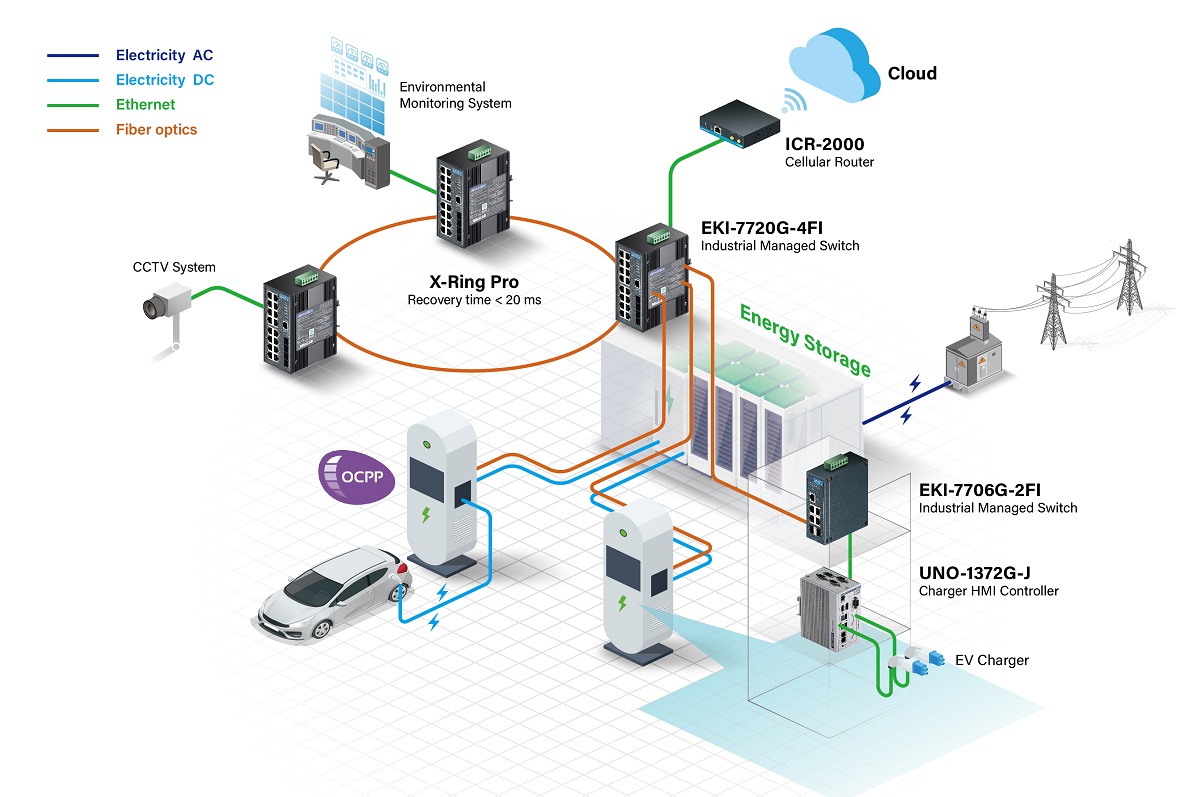
Fundamentals of Industrial CellularRouter Technology
Cellular routers are critical components for business operations connectivity, especially in Industry 4.0 applications where the focus is synthesizing data from connected devices and field assets. Cellular hardware offers solutions that are carrier-agile, cost-competitive, and with flexible configuration interfaces. Devices with open development platforms are imperative to build application software, host applications, manage network connectivity, and securely administer the system.
Industrial routers differ from consumer routers in design, enclosure materials, and certifications. Industrial-based routers must be ruggedized to successfully function in areas—both indoor and outdoor—that may inflict physical, chemical, or electrical damage. These devices may be in areas with dust, vibration, water, temperature fluctuations, physical contaminants, electrical noise, etc. Certain specialized routers may have ingress protection (IP) ratings that help minimize damage.
The Role of Cellular for EV Charging
Cellular networks offer numerous advantages over wired and Wi-Fi-only connections for charging stations. End-to-end EV charging infrastructure connects to multiple devices for data transmission, aggregation, and visualization, in addition to device management. Cellular networks allow stations to communicate via cloud connections with charging service providers, mobility service providers, energy management systems, and smartphone Apps. Some EV chargers may also operate via closed, proprietary platforms depending on business model and ownership.

Deploying cellular routers into industrial networks is more than choosing rugged, reliable hardware— it is taking data intelligence to the network edge. Cellular provides broader coverage, enhanced security, and the ability to connect to the best networks over-the-air (OTA) without the need for physical SIM card swaps, thanks to eSIM technology.
A significant change for EV infrastructure, eSIM technology allows charging stations to automatically switch between different cellular networks to maintain the best possible connection, ensuring near 24/7 uptime. Charging stations remain operational, but a reliable network is also crucial for payment processing, firmware updates, and other OTA services.
Cellular networks also offer a more practical solution when compared to wired networks, due to cost efficiency and extensive coverage. Wireless LTE networks significantly reduce the financial burden associated with laying physical infrastructure. Moreover, cellular networks boast an impressive reach, extending even to sparsely populated areas.
This wide coverage is particularly beneficial for establishing charging stations along highways and in rural service areas where wired connectivity is often limited or non-existent. The presence of multiple cellular networks ensures consistency and resilience, offering alternatives in case of network issues.
Security is a also top concern in EV charging networks, and cellular connections offer more secure data transmission compared to Wi-Fi. Routing technology via LTE allows users to easily establish connectivity between isolated networks with greater flexibility when building secure applications. Cellular remote management capabilities for field devices, such as starting and stopping sessions, setting charging profiles, and unlocking connectors— are essential for a smooth end-user experience.
Wireless Networks in the 5G Era
With its high speed, low latency, and massive IoT device capacity, 5G connectivity holds immense potential for industrial applications, especially real-time applications like EV charging. When compared to 4G LTE connectivity, 5G can transmit 20x faster with only 10-ms latency and increases network capabilities. Low latency enables real-time processing, response, and management for applications.
5G New Radio (NR) provides a suite of vital enhancements in security, reliability, and performance, designed to meet the needs of business and mission-critical applications across the three following categories:
- Ultra-reliable and Low-latency Communications (uRLLC)
- Enhanced Mobile Broadband (eMBB)
- Massive Machine Type Communications (mMTC)
Additionally, 5G offers data security based on strict access control through advanced user and device authentication and network isolation protection. By verifying user credentials and the integrity of devices, 5G networks help prevent unauthorized access and safeguard against potential cybersecurity breaches.
Main Benefits ofCellular Technology inEV Infrastructure
- Deployment of a single solution for connectivity across various charging networks
- Seamless expansion and cost savings with a single connectivity solution for new regions
- Robust and reliable connectivity in all settings: indoors, underground garages, rural areas, etc.
- Flexibility to adapt to various environments and conditions
- Wide coverage for remote areas where Wi-Fi may not be available
- Simplified day-to-day operations for remote devices and systems
- Security protocols for safe data transmission and customer information
- Enhanced reliability and minimized downtime, ensuring consistent service
- Streamlined data exchanges and adaptation to real-time conditions
Successful Industry Use Cases
To meet EV demand and energy infrastructure needs for charging—from the manufacturers who design and build charging stations and energy storage systems (ESS), to the systems integrators (SIs) and software developers who design and implement EV solutions—it is an area ripe for innovation and opportunity.
Advantech has been at the forefront of the global EV technology movement, helping equipment manufacturers, SIs, and independent operators with holistic hardware solutions to successfully deploy applications at every level of e-mobility ecosystems.
EV Charger Design-in forGlobal Manufacturer
A global PEV charger supply manufacturer based in Vietnam needed a connectivity solution that
enabled various EV systems to run simultaneously without interrupting each other. The hardware solution also needed access to worldwide service and long lifecycle for future growth. Additional environmental requirements included a robust design ideal for mission-critical locations—one that could withstand wide temperature fluctuations. Space in the charger cabinet was also limited, requiring compact hardware.
The manufacturer decided to utilize the Advantech ICR-2031 cellular router for LTE connectivity in the charger cabinet. The ICR-2000 series is designed to perform in locations with extreme temperature fluctuations. Additionally, with global service, the Advantech ICR was selected for designs across multiple customer manufacturing sites.
The Hardware
ICR-2031 4G Router
The ICR-2031 industrial cellular router facilitates wireless connectivity, enabling connection of IP devices to a cellular network. For LTE Cat. 4, it boasts a top download speed of approximately 150 Mbps and a peak data rate of 50 Mbps in the uplink. The ICR-2031 router includes one Ethernet port (LAN) and integrated digital input/output connections (1x DI, 1x DO). It can establish secure communication channels through VPN tunnels using multiple protocols.
The ICR-2000 series includes diagnostic features like automatic monitoring of both wireless and wired connections, automatic reboot options (should the connection drop), and a hardware watchdog to oversee overall device status.
Overcoming 3rd-party SoftwareStack Integration
A customer located in the European Union utilized Python to write their own application on top of Advantech firmware and needed to integrate a 3rd-party software stack. The customer needed easy integration options to run custom firmware on Advantech cellular routers. Additional requirements included a device equipped with Wi-Fi for backup connections and customer use.
Advantech ICR-3200 and ICR-2000 series of industrial cellular routers include enhanced memory for numerous RouterApps like Docker, Python, C/C++, and low-code, open-source programming tool Node-RED, with documentation for easy integration. Advantech ICR routers communicate via numerous protocols and host protocol conversion options in RouterApps.
For the Wi-Fi requirements, the ICR-3200 series enables connection to WAN (Internet) via Wi-Fi as a cellular connection backup, but also enables Wi-Fi for clients as an additional service. The ICR-3200 series provides two concurrent SSIDs, working for the station and the client concurrently.
The Hardware
ICR-2041 Entry-Level 4G Router
Part of the ICR-2400 series, the Advantech ICR-2041 is an entry-level 4G router based on the ICR-OS, supporting RouterAPPs for flexible firmware functionalities. The router supports VPN tunnel creation using various protocols to ensure safe communications and is continuously monitoring wireless and wired connections and overall hardware status.
In situations of connection failure, the ICR series includes an automatic restart/reset mechanism. When 4G connectivity is not available, the ICR-2041 supports fallback to 3G options.
Remote Management & Monitoringfor EV Charger System
Recently, a customer required cellular connectivity for their EV charging infrastructure. They required a hardware solution allowing for connection to multiple carriers and included SIM slots to ensure service redundancy. They also aimed to future-proof the system by considering potential deployment of eSIM solutions. The charger units, located in remote areas, also necessitated options for remote management and monitoring to avoid on-site maintenance.
Remote management and monitoring helps reduce overall cost of service with continuous equipment status monitoring and alerts through SMS, email, and alarms. Downtime or device issues are quickly identified and addressed. Lastly, the customer needed to work with a vendor who also provided device accessories, such as antenna options.
To meet all these requirements, the customer implemented both Advantech ICR-3200 and ICR-2000 models of industrial cellular routers. Remote management and monitoring are made simple
with Advantech WebAccess/DMP—a remote device provisioning, monitoring, and management platform available with ICR cellular routers and gateways. With WebAccess/DMP, zero-touch provisioning and configuration are made simple, regardless of deployment size.

An AssureAuth Public Key Infrastructure (PKI) is available for device provisioning, requiring both the device and server to mutually authenticate using Advantech’s Certificate Authority as root of trust. Once successful via a bootstrapping sequence, devices automatically connect with the platform.
Additionally, ICR routers include built-in, secure health-monitoring status indicators reporting to WebAccess/DMP. This data is stored with health data of every device presented in a scalable, time-series visualization for in-depth analysis. A secure, REST-based API supports future growth and can scale-out as necessary.
The Hardware
ICR-3231 Router & IoT Gateway
The ICR-3231 4G LTE gateway connects IP or serial devices via a cellular network with upload speeds up to 50 Mbps and download speeds up to 150 Mbps—ample bandwidth for high-data applications. It includes two SIM card readers for carrier failover redundancy and offers internal eSIM options. In addition to two independent Ethernet ports and RS232/RS485 serial ports, the router includes built-in digital I/O connectivity, real-time clock and sleep mode support, and optional built-in modules for Wi-Fi with 802.11a-b-g-n-ac modes, 2×2 MIMO support, and Bluetooth v5.1.
With an open Linux-based ICR-OS (operating system) and broad possibilities for customer software applications in Python, C/C++, Node- RED, or Docker containers, the ICR-3231 offers a true open development platform for charging infrastructure. Node-RED provides easy-to-use programming to easily fit a variety of applications.
12 Benefits of Advantech ICR Cellular Routers
With cellular connectivity at the forefront, the future of EV charging is secure, connected, and ready to power the electric revolution. In addition to industrial cellular routers, Advantech offers a variety of EV charging infrastructure hardware, including embedded computers, remote I/O, automation controllers, and LoRaWAN gateways, as well as Point-of-Sale (POS) and Human Machine Interface (HMI) solutions.
A key component of effective charging infrastructure, Advantech also provides a complete line of industrial Ethernet switches engineered for demanding conditions. The unmanaged EKI-2000 series includes model options with super-slim, IP30-rated metal enclosures for high reliability and continuous data transmission.
With a high degree of security, EKI-2000 devices are an ideal Ethernet solution in EV charger cabinets. Selecting the right switch is crucial to ensure data packets are transmitted accurately to and from chargers, which prevents delays or interruptions in service.

The Hardware
EKI-2000 Series Unmanaged Ethernet Switch
The EKI-2000 series offers a fast Ethernet solution with a redundant input design and a double protection mechanism through Power Polarity Reverse Protection and Overload Current Resettable Fuse. This level of protection tolerates reverse power switching and secures the system from overload currents.
Each EKI-2525/2528 port has 2 LEDs to show link status transmission speed and collision status. Engineers can verify hardware status via the LED, simplifying troubleshooting. The EKI-2525I provides a relay output for event alarm for events like a power failure.
Reliable EV connectivity is fundamental for consumer demands and environmental sustainability. The dependability and flexibility offered by cellular connectivity is paramount in supporting seamless charging station operation. Cellular not only ensures a better experience for EV users, but also enables the remote management and scalability needed for charging networks to thrive.
Advantech's EV charging solutions tackle diverse development challenges, integrating intelligent software and hardware. With off-the-shelf industrial technology, custom design options, and industry experience, the prospects are endless.

Citations
1. National Renewable Energy Laboratory. (2023). "The 2030 National Charging Network: Estimating U.S. Light-Duty Demand for Electric Vehicle Charging Infrastructure." https://www.nrel.gov/docs/fy23osti/85654.pdf
2. International Energy Agency. (2023). Global EV Outlook 2023. https://www.iea.org/reports/global-ev-outlook-2023
3. International Energy Agency. (2023). Global EV Outlook 2023, "Trends in charging infrastructure." https://www.iea.org/reports/global-ev-outlook-2023/trends-in-charging-infrastructure
4. U.S. Department of Transportation, Federal Highway Administration. (2024). National Electric Vehicle Infrastructure (NEVI). https://www.fhwa.dot.gov/environment/nevi/
5. Brennan Borlaug, Fan Yang, Ewan Pritchard, Eric Wood, Jeff Gonder, “Public electric vehicle charging station utilization in the United States, Transportation Research Part D: Transport and Environment,” Volume 114, 2023; 103564, ISSN 1361-9209. https://www.sciencedirect.com/science/article/abs/pii/S136192092200390X
6. Sarah LaMonaca, Lisa Ryan, “The state of play in electric vehicle charging services – A review of infrastructure provision, players, and policies,” Renewable and Sustainable Energy Reviews, Volume 154, 2022; 111733, ISSN 1364-0321. https://www.sciencedirect.com/science/article/pii/S1364032121010066
7. Smart Cities Dive. (Sept. 2023). "Charging Ahead: How Remote Access Capabilities Improve EV Charging Infrastructure." https://www.smartcitiesdive.com/spons/charging-ahead-how-remote-access-capabilities-improve-ev-charging-infrastr/693654/
8. U.S. Department of Energy. (2024). Electricity Charging Workplace. https://afdc.energy.gov/fuels/electricity_charging_workplace.html
